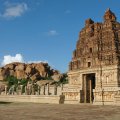VITTALA TEMPLE
This 16th century Unesco World Heritage temple is the highlight of a visit to Hampi. It can be the occasion of a very beautiful walk along the river and in the middle of ruins of temples and bazaars. We strongly recommend that you take a guide to bring to light all the subtleties that this temple conceals.
The construction of the temple would have started under the impulse of the king Krishnadevaraya around 1510. It was never completed, it was not consecrated. Nevertheless, it remains one of the peaks of Vijayanagar art and today tourists flock to admire its chariot and the hall with musical pillars. The complex comprises several pavilions, temples and shrines.
The ratha (chariot) stands at the entrance of the temple and is one of the three most famous in the country. The carts are used to parade the idols of the temples during religious festivals. However, this one has never been driven, as it is actually a shrine dedicated to Garuda, the vehicle of Vishnu. Therefore, the cart faces the main temple dedicated to Vittala, an incarnation of Vishnu. The cart is an assemblage of different blocks of stone finely carved. The joints are hidden in the friezes and scenes decorating the cart. These were painted, and by looking for the less exposed pieces, you can see traces of paint. Wheels were added to complete the similarity with the cart. They used to turn freely around their axis, before the archaeological department blocked them to protect them from visitors who were a bit too playful. Two stone elephants precede the cart, as if pulling it. This is a later addition. Originally, the cart was "pulled" by horses whose tails and hind legs can still be seen behind the elephants. The stone ladder that allowed access to the shrine and the dome that topped it are now gone.
Maha Mandapa. This is the main hall that precedes the entrance to the shrine. It is also called the "musical pillar hall". The main staircase is set on a high platform and is flanked by an elephant-shaped balustrade. The other two staircases on the sides have a balustrade in the shape of a lion fighting an elephant. The proportions have obviously not been maintained. The mandapa is divided into four parts that communicate with each other. The roof of the central hall has unfortunately collapsed and is inaccessible to the public because of its great fragility. Each of the 7 pillars supporting the roof represents a musical instrument. They are subdivided into 7 thinner pillars which, when struck, emit the 7 notes representing the instrument. The English, amazed by this feat, cut out 2 of the pillars to see if they contained anything. They discovered nothing and, even today, the two missing pillars have not been replaced. Is there even a craftsman capable of reproducing this stone miracle? To the eye, if you quickly brush the musical pillars, you will have the impression that they are all identical and strictly parallel. But if you look closely, you will find that some of the pillars are shorter than others, that the base is wider than the top, and that their inclination differs. The Eastern Hall is also called the Musicians' Hall because of the musicians and dancers carved on its main pillars. The southern hall pays homage to Yalis, a mythological creature similar to the lion. Here he stands on his two hind legs and is mounted by a man. The capital of each pillar ends in a lotus bud. The pillars of the northern hall feature Narasimha. The cornices of the roof of the Maha Mandapa take the form of a Chinese pagoda, suggesting that Chinese architects or workers were involved in the construction.
The sanctuary. It is preceded by a walled hall, with an entrance to the north and south. Very bare compared to the mandapa, the sanctuary is empty. Since the temple was never consecrated, the idol was not placed. A narrow ambulatory passage goes around the sanctuary. If you walk through it with a flashlight you will be able to see the delicate lotus flower patterns that decorate the outer wall.
The other buildings. The Vittala temple complex includes three other buildings and a colonnaded surrounding wall. At the entrance to the temple, to the left of the ratha, is the Kalayna Mandapa, or marriage hall. It would have been used for nuptial ceremonies. Moving northward, the 100-pillar hall. Each pillar is carved with different figures. One can see gods, but also scenes of the daily life: scenes of hunting, dance, war... Finally, the last building is a sanctuary dedicated to Devi.
King's balance. By taking the path along the left side of the temple you will see a large carved portico. It is the king's balance. The king weighed himself during special events such as an eclipse of the sun or moon. The counterweight was made of gold coins, precious and semi-precious stones which were then distributed to the priests of the temples of Hampi. One can see on the beam the three rings that were used to suspend the balance. A portrait of the king has been carved on one of the pillars.
Did you know? This review was written by our professional authors.
Book the Best Activities with Get Your Guide
Members' reviews on VITTALA TEMPLE
The ratings and reviews below reflect the subjective opinions of members and not the opinion of The Little Witty.

